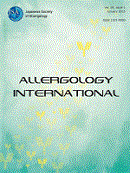Volume 53, Issue 2
Displaying 1-22 of 22 articles from this issue
- |<
- <
- 1
- >
- >|
REVIEW ARTICLE
-
2004 Volume 53 Issue 2 Pages 33-36
Published: 2004
Released on J-STAGE: January 19, 2006
Download PDF (125K) -
2004 Volume 53 Issue 2 Pages 37-45
Published: 2004
Released on J-STAGE: January 19, 2006
Download PDF (449K) -
2004 Volume 53 Issue 2 Pages 47-54
Published: 2004
Released on J-STAGE: January 19, 2006
Download PDF (69K) -
2004 Volume 53 Issue 2 Pages 55-60
Published: 2004
Released on J-STAGE: January 19, 2006
Download PDF (390K) -
2004 Volume 53 Issue 2 Pages 61-68
Published: 2004
Released on J-STAGE: January 19, 2006
Download PDF (209K) -
2004 Volume 53 Issue 2 Pages 69-75
Published: 2004
Released on J-STAGE: January 19, 2006
Download PDF (486K) -
2004 Volume 53 Issue 2 Pages 77-85
Published: 2004
Released on J-STAGE: January 19, 2006
Download PDF (517K) -
2004 Volume 53 Issue 2 Pages 87-92
Published: 2004
Released on J-STAGE: January 19, 2006
Download PDF (247K) -
2004 Volume 53 Issue 2 Pages 93-99
Published: 2004
Released on J-STAGE: January 19, 2006
Download PDF (371K) -
2004 Volume 53 Issue 2 Pages 101-110
Published: 2004
Released on J-STAGE: January 19, 2006
Download PDF (190K) -
2004 Volume 53 Issue 2 Pages 111-119
Published: 2004
Released on J-STAGE: January 19, 2006
Download PDF (177K)
ORIGINAL ARTICLE
-
2004 Volume 53 Issue 2 Pages 121-126
Published: 2004
Released on J-STAGE: January 19, 2006
Download PDF (149K) -
2004 Volume 53 Issue 2 Pages 127-134
Published: 2004
Released on J-STAGE: January 19, 2006
Download PDF (304K) -
2004 Volume 53 Issue 2 Pages 135-144
Published: 2004
Released on J-STAGE: January 19, 2006
Download PDF (569K) -
2004 Volume 53 Issue 2 Pages 145-151
Published: 2004
Released on J-STAGE: January 19, 2006
Download PDF (61K) -
2004 Volume 53 Issue 2 Pages 153-157
Published: 2004
Released on J-STAGE: January 19, 2006
Download PDF (85K) -
2004 Volume 53 Issue 2 Pages 159-167
Published: 2004
Released on J-STAGE: January 19, 2006
Download PDF (72K) -
2004 Volume 53 Issue 2 Pages 169-178
Published: 2004
Released on J-STAGE: January 19, 2006
Download PDF (5063K) -
2004 Volume 53 Issue 2 Pages 179-184
Published: 2004
Released on J-STAGE: January 19, 2006
Download PDF (160K) -
2004 Volume 53 Issue 2 Pages 185-190
Published: 2004
Released on J-STAGE: January 19, 2006
Download PDF (376K)
CASE REPORT
-
2004 Volume 53 Issue 2 Pages 191-192
Published: 2004
Released on J-STAGE: January 19, 2006
Download PDF (36K) -
2004 Volume 53 Issue 2 Pages 193-196
Published: 2004
Released on J-STAGE: January 19, 2006
Download PDF (54K)
- |<
- <
- 1
- >
- >|
